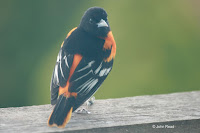BALTIMORE ORIOLE
BALTIMORE ORIOLE – (Icterus galbula) – (See images below)
DESCRIPTION: The Baltimore Oriole male is bright orange with a black head, and black wings with a white band. The bill is conical and black, and the tail has black feathers on top and orange ones on the underside. In the female the color orange is replaced by dull orange-yellow, and the black is replaced by grey. The legs and feet are grey. Juveniles look similar to the female depending on their development stages. The bird is approximately 20 cm (7 inches) long.
VOICE: https://www.xeno-canto.org/species/Icterus-galbula
NAME: The name ‘Baltimore’ refers to an English Lord of the 1700s who had the color orange on his coat of arms. The English name ‘Oriole’ means ‘golden’. The Latin genus name ‘Icterus’ refers both to a yellow bird and the disease jaundice. As for the Latin species name ‘galbula’, it means a ‘small yellow bird’.
HABITAT: Deciduous forest edges and woodlands in and around urban areas, with water nearby.
DIET: Omnivorous – insects, nectar and fruit. When eating fruit it has a preference for dark and ripe ones. It can be attracted to feeders with the latter.
NESTING: The nest of the Baltimore oriole is a remarkable structure of intricately woven material, suspended up in a deciduous tree (see photo below). Around five or six light grey eggs are laid, incubated by the female. Both parents feed the chicks.
DISTRIBUTION: The bird distribution area is mainly the eastern half of North America starting from southern Canada. It migrates to Mexico, Central America and the northernmost part of South America for the winter.
DISTRIBUTION MAP: https://en.wikipedia.org/wiki/Baltimore_oriole#/media/File:Icterus_galbula_map.svg
ON PEI: The Baltimore oriole breeds on Prince Edward Island but is rare.
CONSERVATION: In spite of a recent population decline the species is currently not considered at risk. Threats include spraying forests with pesticides and deforestation.
NOTES: The Baltimore oriole is part of the icterid family of blackbirds. The Baltimore oriole is the state bird of Maryland, and also inspired the name of a baseball team.
SIMILAR SPECIES: Bullock’s Oriole, Orchard Oriole, American Redstart
REFERENCES: https://www.thespruce.com/baltimore-oriole-profile-387222
https://en.wikipedia.org/wiki/Baltimore_oriole
https://www.allaboutbirds.org/guide/Baltimore_Oriole/id
https://www.mba-aom.ca/jsp/toc.jsp (Maritimes Breeding Bird Atlas)
https://www.audubon.org/field-guide/bird/baltimore-oriole
https://nature.mdc.mo.gov/discover-nature/field-guide/baltimore-oriole (Missouri Department of Conservation)
DESCRIPTION: The Baltimore Oriole male is bright orange with a black head, and black wings with a white band. The bill is conical and black, and the tail has black feathers on top and orange ones on the underside. In the female the color orange is replaced by dull orange-yellow, and the black is replaced by grey. The legs and feet are grey. Juveniles look similar to the female depending on their development stages. The bird is approximately 20 cm (7 inches) long.
VOICE: https://www.xeno-canto.org/species/Icterus-galbula
NAME: The name ‘Baltimore’ refers to an English Lord of the 1700s who had the color orange on his coat of arms. The English name ‘Oriole’ means ‘golden’. The Latin genus name ‘Icterus’ refers both to a yellow bird and the disease jaundice. As for the Latin species name ‘galbula’, it means a ‘small yellow bird’.
HABITAT: Deciduous forest edges and woodlands in and around urban areas, with water nearby.
DIET: Omnivorous – insects, nectar and fruit. When eating fruit it has a preference for dark and ripe ones. It can be attracted to feeders with the latter.
NESTING: The nest of the Baltimore oriole is a remarkable structure of intricately woven material, suspended up in a deciduous tree (see photo below). Around five or six light grey eggs are laid, incubated by the female. Both parents feed the chicks.
DISTRIBUTION: The bird distribution area is mainly the eastern half of North America starting from southern Canada. It migrates to Mexico, Central America and the northernmost part of South America for the winter.
DISTRIBUTION MAP: https://en.wikipedia.org/wiki/Baltimore_oriole#/media/File:Icterus_galbula_map.svg
ON PEI: The Baltimore oriole breeds on Prince Edward Island but is rare.
CONSERVATION: In spite of a recent population decline the species is currently not considered at risk. Threats include spraying forests with pesticides and deforestation.
NOTES: The Baltimore oriole is part of the icterid family of blackbirds. The Baltimore oriole is the state bird of Maryland, and also inspired the name of a baseball team.
SIMILAR SPECIES: Bullock’s Oriole, Orchard Oriole, American Redstart
REFERENCES: https://www.thespruce.com/baltimore-oriole-profile-387222
https://en.wikipedia.org/wiki/Baltimore_oriole
https://www.allaboutbirds.org/guide/Baltimore_Oriole/id
https://www.mba-aom.ca/jsp/toc.jsp (Maritimes Breeding Bird Atlas)
https://www.audubon.org/field-guide/bird/baltimore-oriole
https://nature.mdc.mo.gov/discover-nature/field-guide/baltimore-oriole (Missouri Department of Conservation)
 |
| Baltimore oriole, PEI, Roberta Palmer |
 |
| Baltimore oriole female, Joanne Dunphy |
 |
| Baltimore oriole male, back view Dunedin, PEI, by John Read |
 |
| Baltimore oriole, PEI, by John Read |
 |
| Baltimore oriole chicks, by Juliancolton |
 |
| Baltimore oriole male, PEI, John Read |